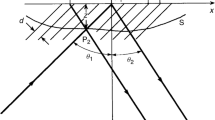Abstract
This paper studies application of the method of projected fringes on measurement of the surface topography of double-curved propeller blades, produced in liquid metal, i.e. NiAl-bronze, with surface areas of about one square meter. The measurements are performed inside a grinding hall of a propeller factory. To meet the challenges encountered in such a demanding environment, it is important to keep the equipment as simple and robust as possible. Therefore, a method is developed for locating the fringe positions with sub-pixel accuracy. To avoid the need for a physical reference plane of sufficient area, a method of extrapolating the fringes projected on a small reference plane is applied. The method has been tested on a grinded propeller blade and the results agree very well compared to a standard manual measurement method.
Similar content being viewed by others
References
Gåsvik KJ 2002. Optical metrology. 3rd ed. Chichester: John Wiley & Sons. ISBN 0–470 84300–4
Sciammarella C et al (2008a) General model for moire contouring, part 1: theory. Opt Eng 47:033605-20
Chen F, Brown GM, Song M (2000) Overview of three-dimensional shape measurement using optical methods. Opt Eng 39:10–22
Wang Z, Du H, Bi H (2006) Out-of-plane shape determination in generalized fringe projection profilometry. Opt Express 14:12122–12133
Huntley JM, Ogundana T, Borguete RL and Coggrave CR 2007. Large-scale full-field metrology using projected fringes: some challenges and solutions. Proc SPIE. June 18 6616 66162C
Sikora JP (1981) Deflection of rotating marine propellers using projected-grating moiré techniques. Exp Mech 21:25–30
Breibarth M, Buchardt C, Kuchmstedt P, Heinze M and Notni G 2008. Measurement of optical free-form surfaces with fringe projection. Proc SPIE, (09/2008)
Clark TA, Robson S and Chen J. A comparison of three techniques for the 3-D measurement of turbine blades. ISMTII, Wuhan, China, SPIE Vol 2101, pp.1–12
Pallek D and Quest J 2003. Model deformation measurement in ETW using the moire technique. 20 th International Congress on Instrumentation in Aerospace Simulation Facilities (ICIASF), 25–29 Aug.
Gåsvik KJ, Robbersmyr KG, Vadseth T, Karimi HR (2014) Deformation measurement of circular steel plates using projected fringes. Int J Adv Manuf Technol 70(1):321–326
Jeong M-S and Kim S-W (2001). Phase-shifting Projection moire for out-of-plane displacement measurement. Proc. SPIE, Vol. 4317, p. 170–179, Second International Conference on Experimental Mechanics
Yoshizawa T, Tomosawa T (1993) Shadow moiré topography by means of phase-shift method. Opt Eng 32(7):1668–1674
Martinez A, Rayas JA, Puga HJ, Genovese K (2010) Iterative estimation of the topography measurement by fringe-projection method with divergent illumination by considering the pitch variation along the x and z directions. Opt and Lasers in Engineering 48:877–881
Huang P and Chiang FP (1999). Recent advances in fringe projection technique for 3D shape measurement. SPIE Conference on Optical Diagnostics for Fluids/Heat/Combustion and Photomechanics for Solids, Colorado, SPIE Vol 3783
Chen L, Quan C (2005) Fringe projection profilometry with nonparallel illumination: a least-squares approach. Opt Lett 3016:2101–2103
Sansoni G, Trebeschi M, Docchio F (2006) Fast 3 D profilometer based upon the projection of a single fringe pattern and absolute calibration. Meas Sci Technology 17:1757–1766
Huang P et al (2005) Trapezoidal phase shifting for three-dimensional shape measurement. Opt Eng 44(12):123601–123609
Takeda M, Ina H, Kobayashi S (1982) Fourier-transform method of fringe-pattern analysis for computer-based topography and interferometry. J Opt Soc Am 72(1):156–160
Takeda M, Mutoh K (1983) Fourier transform profilometry for the automatic measurement of 3-D object shape. Appl Opt 24:3977–3982
Sciammarella C, Lamberti L, Sciammarella FM (2005) High-accuracy contouring using projection moire. Opt Eng 44(9):093605–093617
Salas L, Luna E, Salinas J, Garcia V (2003) Profilometry by fringe projection. Opt Eng 42:3307–3314
Malcom AA, Burton DR and Lalor MJ 1990. Full-field Fourier fringe analysis for industrial inspection. SPIE, (08 / 1990).
Sciammarella C et al (2008b) General model for moire contouring, part 2: applications. Opt Eng 47:033606–033622
Gasvik KJ, Robbersmyr KG, Vadseth T (2010) Projected fringes for the measurement of large aluminum ingots. Meas Sci Technol 21:105302–105311
Spagnolo G et al (2000) Contouring of artwork surface by fringe projection and FFT analysis. Opt Lasers Eng 33:141–156
Waddington C, Kofman J (2014) Modified sinusoidal fringe-pattern projection for variable illuminance in phase-shifting three-dimensional surface-shape metrology. Opt Eng 53:84109
Gåsvik KJ, Robbersmyr KG (1993) Autocalibration of the set up for the projected fringe method. Exp Tech 17(2):41–44
Karimi HR, Maralani PJ, Moshiri B, Lohmann B (2005) Numerically efficient approximations to the optimal control of linear singularly perturbed systems based on Haar wavelets. Int J Comput Math 82(4):495–507
Karimi HR (2006) A computational method for optimal control problem of time-varying state-delayed systems by Haar wavelets. Int J Comput Math 83(02):235–246
Gåsvik KJ, Robbersmyr KG (1994) Error analysis of a zero-crossing algorithm for fringe location. Opt Eng 33:246–250
Author information
Authors and Affiliations
Corresponding author
Rights and permissions
About this article
Cite this article
Robbersmyr, K.G., Gåsvik, K.J., Vadseth, T. et al. Surface topography measurement of double-curved propeller blades using projected fringes. Int J Adv Manuf Technol 91, 375–381 (2017). https://doi.org/10.1007/s00170-016-9764-0
Received:
Accepted:
Published:
Issue Date:
DOI: https://doi.org/10.1007/s00170-016-9764-0




